
Fremantle Stuff > Fremantle History Society > Fremantle Studies > 5 > Murray
Murray, Sandra 2007, 'Escape! Fremantle to Freedom: an exhibition on the Irish Fenian convicts and their bold escape from the Fremantle Prison to America', Fremantle Studies, 5: 74-86.
The exhibition, Escape! Fremantle to Freedom, is based on the dramatic escape of six Irish Fenian Prisoners from the Convict Establishment (Fremantle Prison) in 1876. A Fenian was a member of an association of Irishmen (the Fenian Brotherhood) founded in the late 1850s with the aim of overthrowing the British Government in Ireland. The name comes from Fianna; the legendary warriors of Irish mythology.
Curated by and first shown at Fremantle Prison in December 2006, the exhibition traces the story of the Fenians and their daring escapes to America following the tale from Ireland to England to Australia, and finally to the USA. Convict life is explored in Australia’s last convict Prison; Fremantle Prison. The Fenians were amongst the nal group of convicts sent to England’s distant outpost and were involved in the only two completely successful escapes in the history of the Prison.
The Irish and other cultures have played a vital role in the development of our nation and the shaping of Australian identity. Knowledge of our history, with its fascinating stories, helps our understanding of the present. The Fenians’ escape is part of our history and should be more widely known. It is an epic with winners and losers that is celebrated in America and Ireland; now Australians can rediscover this astonishing event.
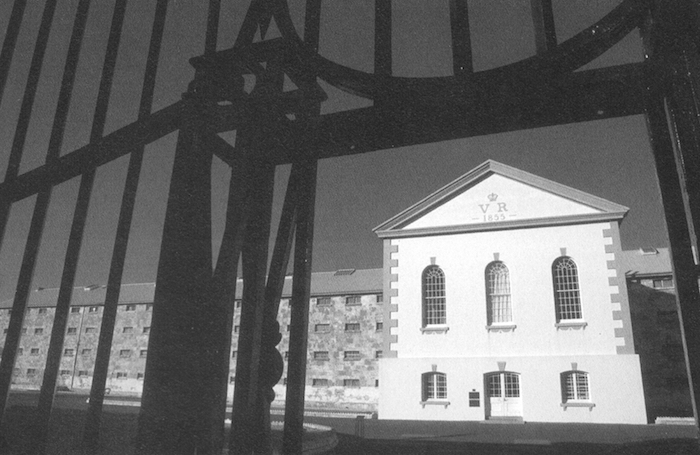
Fremantle Prison, view of Anglican Chapel and Main Cell Block. Photo: Roel Loopers
Although this escape tale is an important part of both Western Australia’s and Australia’s cultural heritage it is little recognised in Australia. Now the exhibition has embarked on a national tour with funding from the State Government of Western Australia, through the Department of Housing and Works, and Visions of Australia. It is the culmination of four years of extensive research by the Prison’s Head Curator and her staff. This is the first time the Prison has curated a major touring exhibition and resulted in the complete upgrade of an exhibition space to international museum standards.
The year 2006 was the 130th anniversary of the Catalpa escape and the visitor is led on a journey through the following themes: the Fenians’ origins in Ireland and their transportation to the Swan River Colony; life as a convict in Australia; the escape of John Boyle O’Reilly from Bunbury to Boston, the rescue plan, the Fenians’ successful escape and its repercussions across the world. From December 2006 to June 2008 Escape! Fremantle to Freedom tours to Western Australian Museum Geraldton, Bunbury Regional Art Galleries, Western Australian Museum Albany, the Australian National Maritime Museum in Sydney, Port Arthur Historic Site and the South Australian Maritime Museum in Adelaide.
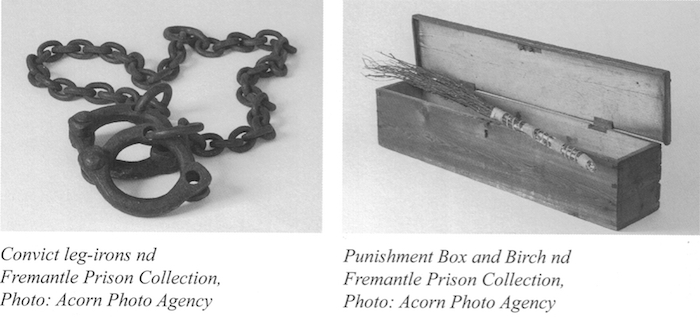
Fremantle Prison is one of Western Australia’s premier cultural heritage sites; it is the last convict Prison built in Australia and remains the most intact. It was constructed by convict labour in the 1850s from local limestone quarried from the actual Prison site. Originally called the Imperial Convict Establishment, it was known as The Convict Establishment and became Fremantle Prison in 1867. Control of the Prison was transferred to the Western Australian colonial government in 1886. It operated as the State’s maximum security Prison until 1991 and opened in 1992 as a public heritage site. The Prison was listed on the National Heritage List in 2005, the 14th site in Australia and the first in Western Australia. It also forms part of the Australian Convict Sites Nomination for World Heritage listing.
The Prison had more than 500 cells, plus four large dormitories. A large Protestant Chapel was built in front of the main cellblock. There were both Protestant and Roman Catholic convicts from the first arrival onwards, but the Protestant conventions of British sectarianism continued in the new Prison as it had before between the English and Irish. A smaller Catholic Chapel was only added in 1861 after Superintendent Lefroy recommended that the northern Association Ward be altered as a place of worship for Catholics.
There is increasing appeal in tracing family genealogy in Australia, especially from convict origins and Escape! Fremantle to Freedom taps directly into this interest. Over 160000 convicts were transported from England, Ireland and the British colonies to Australia between 1788 and 1868. About 80000 convicts were sent to New South Wales while Van Diemen’s Land received 69000. The last convicts to land in eastern Australia arrived in Tasmania in 1852. In contrast, Western Australia only started receiving convicts in 1850, becoming the last penal colony in the British Empire. Some 9720 British male convicts were sent to the Swan River Colony between 1850 and 1868.
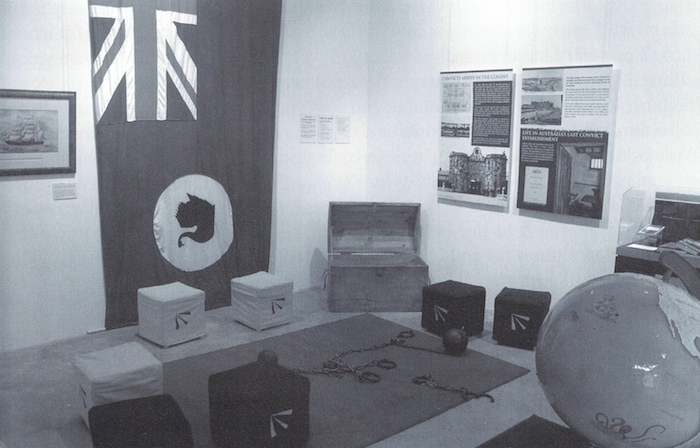
Escape! Exhibition 2006, Fremantle Prison Children’s interactive area, Photo: Tony Nathan

Catalpa ship model 2006, Made by Nick Burningham Fremantle Prison Collection, Photo: Paul Caporn
A convict’s life in the Establishment revolved around work. He was assigned to either a work party for the major construction works around the colony, or for labour, such as carpentry in the Prison workshops. Severe rules and regulations were strictly enforced. Two forms of harsh corporal punishment were administered: flogging and birching. Rare convict artefacts and Prison correspondence from the Fremantle Prison collection are featured in the exhibition to give a tangible picture of convict life in Western Australia such as a cat o’ nine tails, flogging birches and an 1852 communion set.
A dynamic approach to the interpretation of this exhibition ensures participatory learning opportunities for children to bring the convict world alive. These include a treasure chest filled with child size convict costumes and replica leg irons for dress-ups (adults enjoy these too!) and a giant freestanding globe with the sea voyages of the convicts and their rescuers marked on it. The journeys are painted in raised colour coded dots so children can trace the different routes. In addition, a free education program is available on the Prison website for upper primary and secondary students. Another component that draws attention is a 1:50 commissioned scale model of the Catalpa, which the model maker completed in the exhibition space during opening hours.
The Fenian movement or Irish Republican Brotherhood flourished until their unsuccessful armed rebellion against the British in 1865 led to the arrest of hundreds of men in Ireland on suspicion of complicity. There were two groups of men charged and convicted: civilians and those serving in the British military services. The arrested civilians were treated as political Prisoners, however the military men were treated more harshly as criminals because they had betrayed the British army.
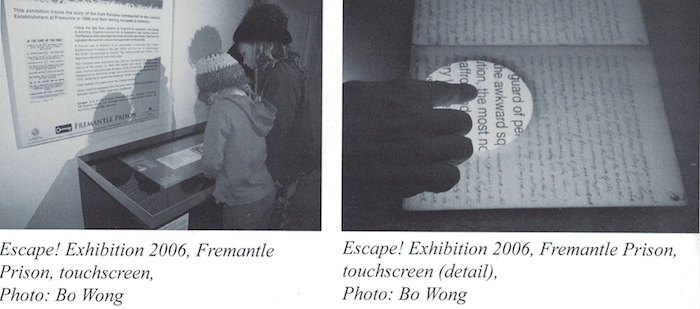
The British Government, desperate to relieve itself of the Fenian problem, decided to transport two-thirds of its Fenian inmates to Australia. Subsequently 280 convicts, including 62 Fenians, sailed on the Hougoumont from Portland, England on 12 October 1867. They arrived at Fremantle on 9 January 1868, the last convicts to be sent to Australia. They were the first Fenian convicts to come to the Swan River colony and their arrival was not welcome due to the many rumours about their unlawful ways. However many of the Fenians were educated men, including schoolteachers, tradesmen and the journalist John Boyle O’Reilly, who along with fellow Fenian John Flood wrote an illustrated weekly journal on the voyage called The Wild Goose: A Collection of Ocean Waifs.
Two innovative interactive touchscreens provide an in-depth opportunity to look at Fenian related documents such as the Wild Goose papers (held by the Mitchell Library, State Library of NSW) that are inaccessible to the majority of the general public. Many of the fascinating paper records of the story are too fragile to tour and this is the first time the public has viewed them, including two unique handwritten Fenian diaries from the National Library of Ireland. Historic newspaper articles that are on microfilm only are also reproduced here, such as the Irish World with its subversive cartoons.
A Scotland Yard Detective, Thomas Rowe, was sent on the Hougoumont to maintain surveillance of the Fenians. He travelled in disguise as an Assistant Warder and later, as Detective Sergeant of the Western Australian Police, was instrumental in the pursuit and investigation of the Fenians. On display for the first time are several items directly connected to Rowe. These personalise the story, bringing to life some of the key players. There is a sword owned by Rowe on show that has been treasured in the family for over 100 years as well as a photograph of him in full police regalia with this very sword.
In 1876 Rowe began writing a weekly publication, the WA Police Gazette. An original issue of the Gazette dated 19 April 1876 is on loan from the John J Burns Library at Boston College. In it Rowe lists the escapes of John Boyle O’Reilly in 1869 and the Fenian absconders on the Catalpa. It was posted to the officer in charge of Police in New Bedford in Massachusetts (the stamped, addressed envelope is also part of the display) to alert them to the escapees. In a strange twist, this officer was Henry Hathaway, who had helped with both the escapes! Hathaway assisted in O’Reilly’s rescue, as he was second mate on the Gazelle. One can surmise he ignored the information in the Gazette.
The travelling exhibition shows the national relevance of Australia’s convict and maritime heritages as common links between the states where it is being shown.
Specific regional venues in Western Australia were targeted for their links to the story; Albany, Bunbury and Geraldton all had convict depots or gaols, and O’Reilly escaped from near Bunbury. They are all historic, coastal ports with an association with whaling and maritime exploration. To support the maritime theme a full scale whaleboat equipped with replica fittings is a centrepiece of the exhibition. A soundscape is triggered when visitors approach the boat; one of the many design techniques used throughout Escape! Fremantle to Freedom to make it a multi layered sensory experience.
John Boyle O’Reilly was a newspaper cadet reporter before joining the British Army in 1863. He was appointed to the 10th Hussars, the prestigious cavalry regiment of the Prince of Wales. That year he also became a member of the Fenian Brotherhood and was arrested in 1866 for assisting fellow soldiers to join. At his court martial he was found guilty, but his death sentence was commuted to life imprisonment. As with many of the convicted Fenians this automatically meant transportation to Fremantle.
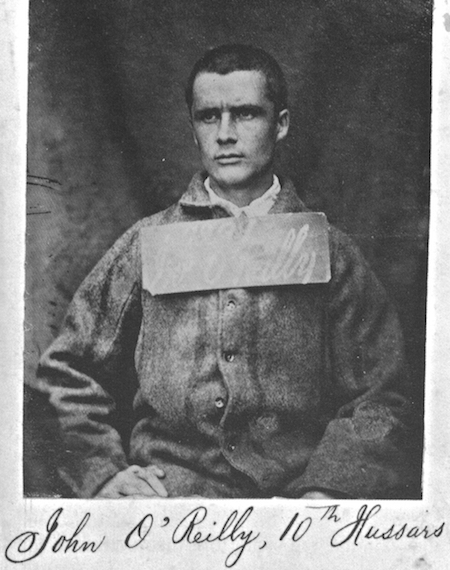
John Boyle O’Reilly c1867 Fenian Mugshot, Mountjoy Prison, Dublin,
Courtesy Kevin Cusack, USA
Shortly after arriving, O’Reilly was transferred to a convict work party near Bunbury. He confided his desire to escape to Roman Catholic priest, Father Patrick McCabe. Local Irish settler Jim Maguire organised his passage on board American whaler the Vigilant in February 1869. The rendezvous with the whaler collapsed when the ship failed to sight O’Reilly in a small rowing boat off the coast near Australind. By now the police and Aboriginal trackers were chasing him. Hiding in the sand dunes at Buffalo Beach, O’Reilly spent many days of anguish in the scorching summer heat until McCabe arranged for another whaler, the Gazelle, to collect him. Despite an international pursuit for O’Reilly, he managed to arrive safely in Boston later this year.
It was also in 1869 that Britain granted freedom to over half the imprisoned Fenians at Fremantle (notably civilian prisoners), partly in an attempt to win favour with Ireland. Yet freedom was denied to the military Prisoners. There were only 12 Fenians remaining in the establishment in 1874. There was utter despair amongst these men, as evident in Fenian James Wilson’s letter to fellow Fenian John Devoy in America:
Fremantle Prison, 15 June 1874
... remember this is a voice from the tomb. For is not this a living tomb... Think that we have been nearly nine years in this living tomb since our first arrest, and that it is impossible for mind or body to withstand the continual strain that is upon them. One or the other must give way ... 1
The exhibition features significant loans from key public and private collections in Australia, Ireland and America to enliven the dramatic period of history described above. There are several special items on loan from the New Bedford Whaling Museum in Massachusetts including the letter box and logbook of the Gazelle. The logbook is written in Portuguese, the native language of the logbook keeper, John A Vieira. The pages displayed are from February 1869 where Vieira notes that the captain hid two men who had escaped from Western Australia: O’Reilly and Thomas Henderson, an ex-convict who forced his way into the escape plan.
With fellow Clan na Gael (America’s Irish Republican Brotherhood) members, John Devoy and O’Reilly plotted to free the Fenians still incarcerated at Fremantle Prison. The group purchased a ship for the rescue with funds raised from supporters and disguised it as an operational whaler. The Catalpa departed New Bedford, south of Boston, for the Atlantic whaling grounds on 29 April 1875. On board, only the captain, an American named George Smith Anthony and a representative of the conspirators, Dennis Duggan who posed as the ship’s carpenter, knew its ultimate mission.
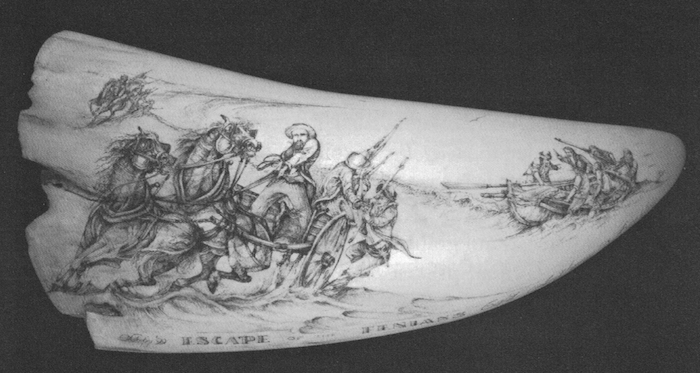
Gary Tonkin Escape of the Fenians 1988-99
hand-engraved scrimshaw on sperm whale tooth pigmented with Indian ink, Private Collection, Photo: Andrew Cross
In February 1876, during the voyage to Australia, the Catalpa met the trader Ocean Beauty. By a remarkable coincidence its captain had been master of the Hougoumont; the same ship that transported the Fenians to Fremantle. The Ocean Beauty’s master, thinking he was assisting a fellow mariner in the legitimate pursuit of whales, provided Captain Anthony with copies of navigation charts of the area. Little did he know he was aiding a daring plot against the British Government.
Two Fenian agents travelled from America to initiate the ground rescue operation in late 1875. The men, John Breslin and Thomas Desmond, arrived in Albany and took the coastal steamer Georgette to Fremantle. Breslin successfully posed as a wealthy businessman in Fremantle so as to gain people’s confidence and establish lines of communication, whilst Desmond went undercover as a carriage builder in Perth. As an international visitor, Breslin was even given a full tour of the Prison by the unsuspecting Assistant Superintendent Joseph Doonan. Breslin met secretly on several occasions with the Fenian convicts and local Irish conspirators to plot the getaway.

Escape! Exhibition 2006, Fremantle Prison with Georgette bell
(courtesy of Augusta Historical Museum & Custodian Mr T. Watkins) in foreground, Photo: Tony Nathan
After much anticipation the Catalpa arrived at Bunbury on 29 March 1876. Captain Anthony sailed to Fremantle on the Georgette with Breslin who had arranged for contact to be made with the Fenians. On Easter Monday 17 April 1876, six Fenian Prisoners (James Wilson, Thomas Darragh, Martin Hogan, Michael Harrington, Robert Cranston and Thomas Hassett) slipped away from Prison work parties. They fled in two horse drawn buggies to Rockingham to the waiting whaleboat. The water police and the Georgette failed in their attempts to recapture the escapees. Out at sea the whaleboat carrying the Prisoners sighted the Catalpa but in the gathering darkness a fierce squall struck them and they lost contact. The men were forced to spend an uncomfortable, unscheduled night in the open boat.
The next morning the Georgette armed with a 12-pound howitzer canon and bristling with soldiers approached the Catalpa once more. Superintendent Stone called on the ship to stop and fired a canon shot across its bow. The Catalpa stopped, but Captain Anthony claimed they were in international waters and dared the British to fire again, ‘That’s the American flag; I am on the high seas; my flag protects me; if you fire on this ship you fire on the American flag’. 2
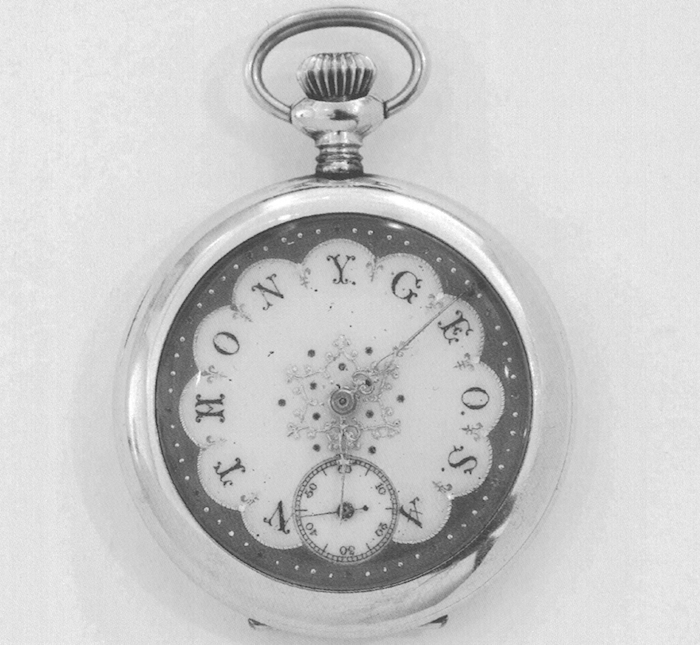
Captain Anthony’s watch, nd
Private Collection, USA, Photo: Tony Nathan
Stone, not wanting to spark an international incident (Britain had been forced to pay £3 million in a case involving a similar situation with an American ship), felt he had no choice. He reluctantly allowed the Catalpa, with the felons now on board, to sail away to freedom. On 19 August 1876 the Fenians arrived triumphantly in New York.
This description illustrates that the exhibition’s content is of international cultural signi cance as the adventure reaches over four countries, and demonstrates their contrasting legal systems. In Ireland the Fenians were seen as rebels and patriots, in England and Australia they were considered dangerous criminals (although there was considerable local Irish support in Australia), while in America they were praised as heroes.
Although this incredible tale remains largely unknown in Australia, the issues surrounding the incarceration and escape of the Fenians also remain current. For example, in 1999 the then State opposition leader, Geoff Gallop made an unsuccessful request to the English Government for a conditional pardon for John Boyle O’Reilly.
Cultural material spanning the globe was sourced for Escape! Fremantle to Freedom and incorporated artefacts, artworks, maps, books, flags, letters and uniforms from both private and public collections. National and international loans, with many objects having never been on display before, include: Fenian material from Kilmainham Gaol in Dublin and the National Museum of Ireland; a unique O’Reilly stenography notebook from Meath County Library in Ireland; artworks from the Kerry Stokes Collection and the Australian National Maritime Museum; and, a specially commissioned gold pocket watch presented to the Catalpa’s captain by the Irish Patrick Sarsfield Club on 2 March 1908 in Waterbury in Connecticut, USA. The watch commemorates the successful rescue of the Fenians by the Catalpa. It is engraved with an intricate picture of the Catalpa and made of thick gold plating. The watch has been passed down through the descendents of Captain Anthony.
A letter from Henry Maxwell Lefroy, the former Superintendent of the Prison, to his brother John Henry Lefroy, the Governor of Bermuda, sums up the situation in Perth after the failure to capture the Fenians:
June 10, 1876.
We have just had a very exciting event in the escape from the Colony of six of the principal Fenian military Prisoners... The British Government detectives in America had discovered this project, and communicated it to the Foreign Office, which again warned our Governor of it. The latter contented himself with warning the Controller, who again did nothing whatever to meet and defeat the plot. I guess that both he and the Governor will get a very unpleasant wigging from the Colonial Office later on. 3
There was a thorough inquiry into the escape, which had serious repercussions for a number of Prison and police staff. Joseph Doonan, Assistant Superintendent of the Prison and an Irishman, was made a principal scapegoat as he had been told of the possibility of a Fenian escape by Acting Comptroller Fauntleroy. But Doonan had been instructed explicitly by his superiors not to take any precautionary measures, as the threat was considered minor. Catastrophically he blamed himself and, despite being exonerated, attempted suicide and later resigned. Fauntleroy was dismissed, along with several others.
The lack of military protection in the colony was partly to blame, as was poor communication between the government authorities and their failure to take the warnings seriously. The fear of a Fenian invasion persisted for years afterwards. The paranoia in the colony was manifest, as evidenced in this report from Chief Superintendent of Police, Matthew Smith to Governor Robinson, dated 31 May 1880: ‘I should not be at all surprised to hear of an armed vessel arriving off Fremantle levying a large contribution from the town, possibly destroying it and then making off’. 4
The Catalpa story touched many lives and it is vital to capture these memories in its telling. With much of the local oral history not being recorded, the exhibition features a lm of interviews that were researched and produced by the Prison. Entitled The Catalpa Legacy, these interviews present local historians and descendents of those who played a part in the Fenians’ escape including: John Rowe, the great, great grandson of Detective Sergeant Thomas Rowe; Mervyn Reger, descendant of James Bell who witnessed the Fenians’ escape on Rockingham Beach; Sue Hart, descendant of Joseph Doonan; and, Sir William Heseltine, local historian and descendant of Assistant Warder George Canham Payne who gave evidence at the escape inquiry.
In 1890 O’Reilly died tragically from an accidental overdose of sleeping medicine at the age of 46. A popular, talented literary man and a passionate believer in the Irish cause, his funeral and memorial service were the largest ever held in America for an Irishman prior to that of John F Kennedy.
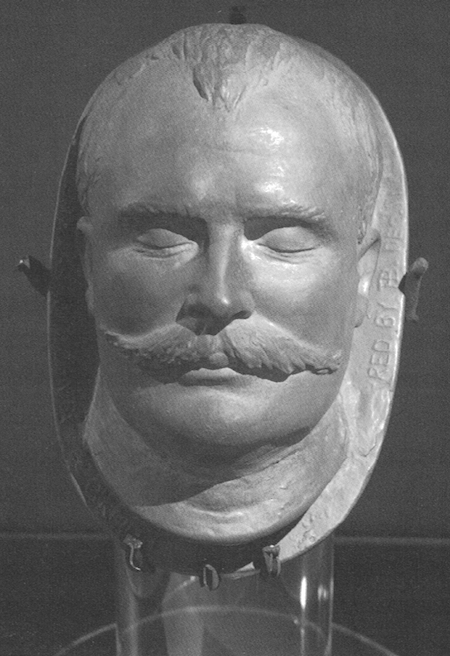
Death mask of John Boyle O’Reilly 2006 Replica, Fremantle Prison Collection, Gift of the National Museum of Ireland, Photo: Tony Nathan
It is therefore pertinent that one of the most striking exhibits in Escape! Fremantle to Freedom is a life-size replica death mask of O’Reilly. This was made by the Conservation Department of the National Museum of Ireland and was gifted by the Museum to Fremantle Prison; a considered gesture which acknowledges the cultural and political bonds between the two countries.
Fremantle Studies Day, October 2006
1 P Stevens, The Voyage of the Catalpa; A perilous journey and six Irish rebels’ ‘Flight to Freedom’, Carroll & Graf, New York, 2002, pp 150-151.
2 J Breslin, ‘The Escaped Fenians, Narrative of Mr John J Breslin’, Irish World, 1876.
3 C E C Lefroy, Memoir of Henry Maxwell Lefroy, Billing & Sons Ltd, Surrey, 1934, p 142.
4 Report of Chief Superintendent of Police to Governor Robinson, 31/5/1880.
Garry Gillard | New: 2 November, 2017 | Now: 16 December, 2018